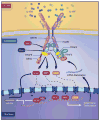IL-17: overview and role in oral immunity and microbiome
- PMID: 27763707
- PMCID: PMC5398954
- DOI: 10.1111/odi.12598
IL-17: overview and role in oral immunity and microbiome
Abstract
Interleukin-17 (IL-17) is a multifaceted cytokine with diverse roles in both immune protection and also immunopathology. IL-17 has a well-recognized role in immune surveillance at mucosal and barrier surfaces, but also has been increasingly implicated as a driver of immunopathology in settings of autoimmunity and chronic inflammation. The current review introduces basic aspects of IL-17 biology and examines the protective and pathogenic roles of IL-17 with a focus on oral mucosal immunity and inflammation. Specific emphasis is given to the role of the IL-17 response as a catalyst in 'shaping the microbiome at the oral barrier'.
Keywords: IL-17; Th17; oral microbiome; oral mucosal immunity.
Published 2016. This article is a U.S. Government work and is in the public domain in the USA.
Figures





References
-
- Acosta-Rodriguez EV, Napolitani G, Lanzavecchia A, Sallusto F. Interleukins 1beta and 6 but not transforming growth factor-beta are essential for the differentiation of interleukin 17-producing human T helper cells. Nat Immunol. 2007a;8:942–9. - PubMed
-
- Acosta-Rodriguez EV, Rivino L, Geginat J, Jarrossay D, Gattorno M, Lanzavecchia A, Sallusto F, Napolitani G. Surface phenotype and antigenic specificity of human interleukin 17-producing T helper memory cells. Nat Immunol. 2007b;8:639–46. - PubMed
-
- Allam JP, Duan Y, Heinemann F, Winter J, Gotz W, Deschner J, Wenghoefer M, Bieber T, Jepsen S, Novak N. IL-23-producing CD68(+) macrophage-like cells predominate within an IL-17-polarized infiltrate in chronic periodontitis lesions. J Clin Periodontol. 2011;38:879–86. - PubMed
Publication types
MeSH terms
Substances
Grants and funding
LinkOut - more resources
Full Text Sources
Other Literature Sources

